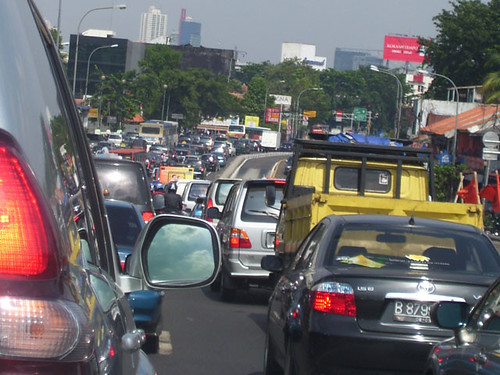(Source: AFP via Google, ITDP & Jakarta Post)
 New laws requiring disabled pedestrians to wear traffic signs have met with frustration and derision in Indonesia, where in the eyes of the law cars have taken priority over people.
New laws requiring disabled pedestrians to wear traffic signs have met with frustration and derision in Indonesia, where in the eyes of the law cars have taken priority over people.
The laws will do nothing to improve road safety or ease the traffic that is choking the life out of the capital city of some 12 million people, and serve only to highlight official incompetence, analysts said.
Within five years, if nothing changes, experts predict Jakarta will reach total gridlock, with every main road and backstreet clogged with barely moving, pollution-spewing cars.
That’s too late for the long-awaited urban rail link known as the Mass Rapid Transit (MRT), which has only just entered the design stage and won’t be operational until 2016 at the earliest.
“Just like a big flood, Jakarta could be paralysed. The city’s mobility will die,” University of Indonesia researcher Nyoman Teguh Prasidha said.
Instead of requiring level footpaths and ramps, lawmakers voted unanimously this month to demand disabled people wear signs announcing their condition so motorists won’t run them down as they cross the street.
Experts say the new traffic law is sadly typical of a country which for decades has allowed cars and an obsession with car ownership to run rampant over basic imperatives of urban planning.
“It is strange when handicapped people are asked to carry extra burdens and obligations,” Institute of Transportation Studies (Instran) chairman Darmaningtyas said.
A 2004 study by the Japan International Cooperation Agency found that traffic jams cost Jakarta some 8.3 trillion rupiah (822 million dollars) a year in extra fuel consumption, lost productivity and health impact.
Paralyzing traffic jams and severe air pollution are the most frequent answers when people are asked what they know about Jakarta. Motorized vehicle ownerships increase in line with a rise in income per capita.
An Institute for Transportation and Development Policy (ITDP) study notes that motorized vehicle ownership is growing at 9 percent every year, with more than 1,500 new registrations being filed a day for motorcycles and 500 a day for cars. The study discusses various options including BRT, incentives for biking, etc to manage the growing congestion problem that is now threatening to cripple the growth of the country’s economy and adversely affect the quality of life of its citizens.
Now, growth of the vehicle population is not the only problem. The drivers behind the wheel are adding to the chaos on the roads. An article that recently appeared in the online edition of Jakarta Post, says the following: Driving in Jakarta is nothing short of chaotic, thanks to the huge quantity of people using the roads, the often terrible condition of the roads and the vast variety of vehicles there are. All of this chaos is only made worse by drivers who are reckless and dismissive of other road users.
There are drivers that seem utterly oblivious to there being anybody else on the roads except themselves. Perhaps they are too comfortable in the enclosed air-conditioned capsule that is their vehicle, as they listen to pumped-up stereophonic music or even watch small video screens, to pay any attention or care about anyone else on the roads.
Click here to read the entire article.


